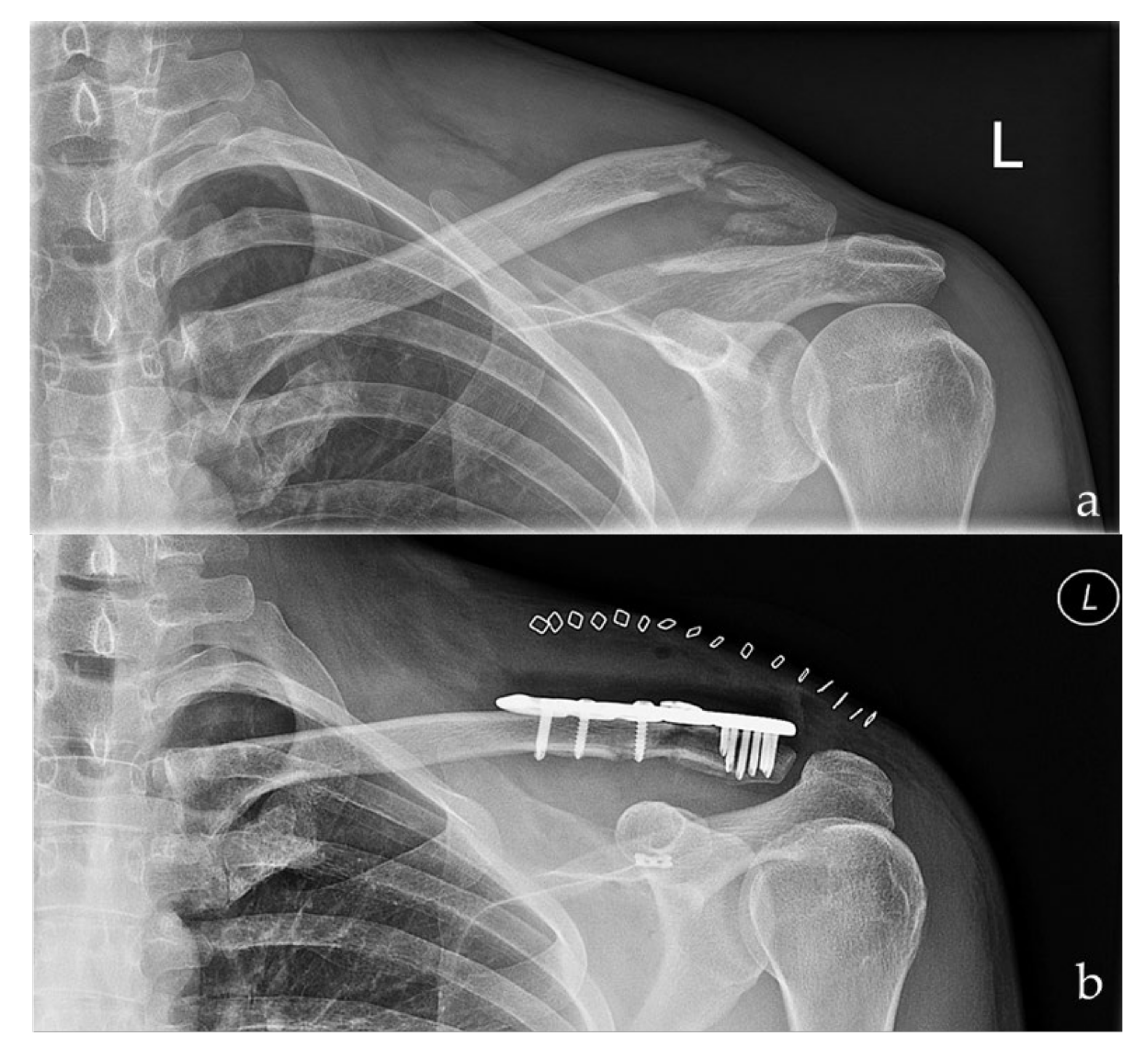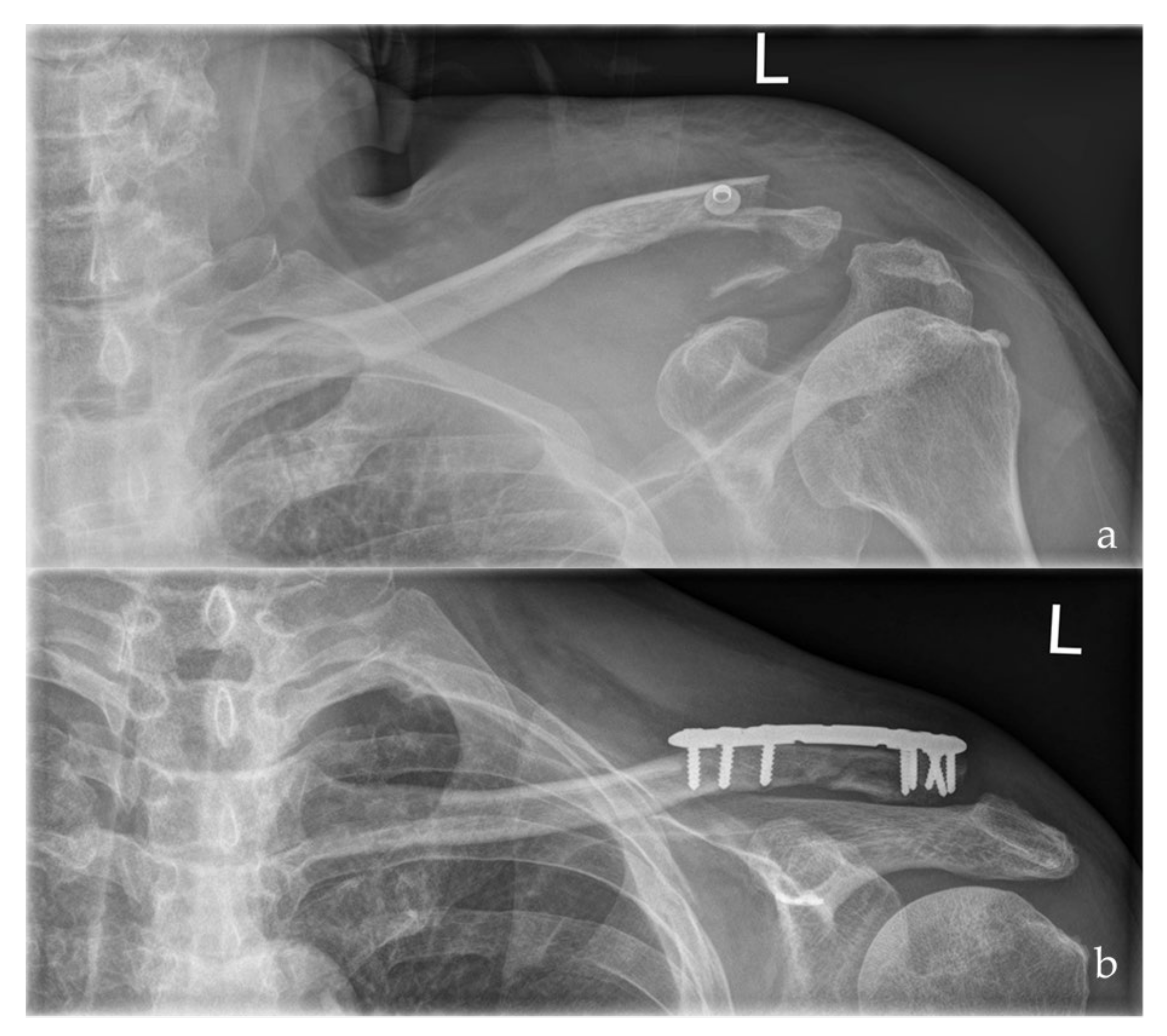Good to Excellent Functional Outcome and High Return to Sports Rate after Operative Treatment of Unstable Lateral Clavicle Fractures: Comparison of Two Coracoclavicular Button Fixation Techniques
Abstract
:1. Introduction
2. Materials and Methods
2.1. Surgical Technique
2.2. Follow up Evaluation
2.3. Statistical Analysis
3. Results
3.1. Limitation of Range of Motion/Irritation and Implant Removal
3.2. Return to Sports
4. Discussion
4.1. Irritation Rates
4.2. Return to Sports
4.3. Arthroscopic Assisted Operative Treatment
4.4. Functional Outcome
5. Limitations
6. Conclusions
Author Contributions
Funding
Institutional Review Board Statement
Informed Consent Statement
Data Availability Statement
Conflicts of Interest
References
- Beirer, M.; Siebenlist, S.; Cronlein, M.; Postl, L.; Huber-Wagner, S.; Biberthaler, P.; Kirchhoff, C. Clinical and radiological outcome following treatment of displaced lateral clavicle fractures using a locking compression plate with lateral extension: A prospective study. BMC Musculoskelet. Disord. 2014, 15, 380. [Google Scholar] [CrossRef] [Green Version]
- Stegeman, S.A.; Nacak, H.; Huvenaars, K.H.; Stijnen, T.; Krijnen, P.; Schipper, I.B. Surgical treatment of Neer type-II fractures of the distal clavicle: A meta-analysis. Acta Orthop. 2013, 84, 184–190. [Google Scholar] [CrossRef]
- Neer, C.S., 2nd. Fractures of the distal third of the clavicle. Clin. Orthop. Relat. Res. 1968, 58, 43–50. [Google Scholar] [CrossRef]
- Bisbinas, I.; Mikalef, P.; Gigis, I.; Beslikas, T.; Panou, N.; Christoforidis, I. Management of distal clavicle fractures. Acta Orthop. Belg. 2010, 76, 145–149. [Google Scholar]
- Robinson, C.M.; Cairns, D.A. Primary nonoperative treatment of displaced lateral fractures of the clavicle. J. Bone Joint Surg. Am. 2004, 86, 778–782. [Google Scholar] [CrossRef]
- Kapicioglu, M.; Erden, T.; Bilgin, E.; Bilsel, K. All arthroscopic coracoclavicular button fixation is efficient for Neer type II distal clavicle fractures. Knee Surg. Sports Traumatol. Arthrosc. 2020, 29, 2064–2069. [Google Scholar] [CrossRef]
- Donnelly, T.D.; Macfarlane, R.J.; Nagy, M.T.; Ralte, P.; Waseem, M. Fractures of the clavicle: An overview. Open Orthop. J. 2013, 7, 329–333. [Google Scholar] [CrossRef] [Green Version]
- Lazarides, S.; Zafiropoulos, G. Conservative treatment of fractures at the middle third of the clavicle: The relevance of shortening and clinical outcome. J. Shoulder Elbow Surg. 2006, 15, 191–194. [Google Scholar] [CrossRef]
- Boonard, M.; Sumanont, S.; Arirachakaran, A.; Sikarinkul, E.; Ratanapongpean, P.; Kanchanatawan, W.; Kongtharvonskul, J. Fixation method for treatment of unstable distal clavicle fracture: Systematic review and network meta-analysis. Eur. J. Orthop. Surg. Traumatol. 2018, 28, 1065–1078. [Google Scholar] [CrossRef]
- Lee, W.; Choi, C.-H.; Choi, Y.-R.; Lim, K.-H.; Chun, Y.-M. Clavicle hook plate fixation for distal-third clavicle fracture (Neer type II): Comparison of clinical and radiologic outcomes between Neer types IIA and IIB. J. Shoulder Elbow Surg. 2017, 26, 1210–1215. [Google Scholar] [CrossRef]
- Alaee, F.; Apostolakos, J.; Singh, H.; Holwein, C.; Diermeier, T.; Cote, M.P.; Beitzel, K.; Imhoff, A.B.; Mazzocca, A.D.; Voss, A. Lateral clavicle fracture with coracoclavicular ligament injury: A biomechanical study of 4 different repair techniques. Knee Surg. Sports Traumatol. Arthrosc. 2017, 25, 2013–2019. [Google Scholar] [CrossRef] [PubMed]
- Rieser, G.R.; Edwards, K.; Gould, G.C.; Markert, R.J.; Goswami, T.; Rubino, L.J. Distal-third clavicle fracture fixation: A biomechanical evaluation of fixation. J. Shoulder Elbow Surg. 2013, 22, 848–855. [Google Scholar] [CrossRef] [PubMed]
- Sautet, P.; Galland, A.; Airaudi, S.; Argenson, J.N.; Gravier, R. Arthroscopy-assisted fixation of fracture of the distal part of the clavicle by subcoracoid suture and clavicle button. Orthop. Traumatol. Surg. Res. 2018, 104, 1237–1240. [Google Scholar] [CrossRef]
- Singh, R.; Rambani, R.; Kanakaris, N.; Giannoudis, P.V. A 2-year experience, management and outcome of 200 clavicle fractures. Injury 2012, 43, 159–163. [Google Scholar] [CrossRef]
- Robertson, G.A.; Wood, A.M. Return to sport following clavicle fractures: A systematic review. Br. Med. Bull. 2016, 119, 111–128. [Google Scholar] [CrossRef]
- Neer, C.S., 2nd. Fracture of the distal clavicle with detachment of the coracoclavicular ligaments in adults. J. Trauma 1963, 3, 99–110. [Google Scholar] [CrossRef]
- Fleming, M.A.; Dachs, R.; Maqungo, S.; du Plessis, J.-P.; Vrettos, B.C.; Roche, S.J.L. Angular stable fixation of displaced distal-third clavicle fractures with superior precontoured locking plates. J. Shoulder Elbow Surg. 2015, 24, 700–704. [Google Scholar] [CrossRef]
- Hanflik, A.; Hanypsiak, B.T.; Greenspoon, J.; Friedman, D.J. Open reduction internal fixation of distal clavicle fracture with supplementary button coracoclavicular fixation. Arthrosc. Tech. 2014, 3, e551–e554. [Google Scholar] [CrossRef]
- Loriaut, P.; Moreau, P.E.; Dallaudiere, B.; Pélissier, A.; Vu, H.D.; Massin, P.; Boyer, P. Outcome of arthroscopic treatment for displaced lateral clavicle fractures using a double button device. Knee Surg. Sports Traumatol. Arthrosc. 2015, 23, 1429–1433. [Google Scholar] [CrossRef]
- Metzlaff, S.; Rosslenbroich, S.; Forkel, P.H.; Schliemann, B.; Arshad, H.; Raschke, M.; Petersen, W. Surgical treatment of acute acromioclavicular joint dislocations: Hook plate versus minimally invasive reconstruction. Knee Surg. Sports Traumatol. Arthrosc. 2016, 24, 1972–1978. [Google Scholar] [CrossRef]
- Pujol, N.; Philippeau, J.M.; Richou, J.; Lespagnol, F.; Graveleau, N.; Hardy, P. Arthroscopic treatment of distal clavicle fractures: A technical note. Knee Surg. Sports Traumatol. Arthrosc. 2008, 16, 884–886. [Google Scholar] [CrossRef]
- Takase, K.; Kono, R.; Yamamoto, K. Arthroscopic stabilization for Neer type 2 fracture of the distal clavicle fracture. Arch. Orthop. Trauma Surg. 2012, 132, 399–403. [Google Scholar] [CrossRef] [PubMed]
- Beirer, M.; Zyskowski, M.; Cronlein, M.; Pförringer, D.; Schmitt-Sody, M.; Sandmann, G.; Huber-Wagner, S.; Biberthaler, P.; Kirchhoff, C. Concomitant intra-articular glenohumeral injuries in displaced fractures of the lateral clavicle. Knee Surg. Sports Traumatol. Arthrosc. 2017, 25, 3237–3241. [Google Scholar] [CrossRef] [PubMed]
- Hung, L.K.; Su, K.C.; Lu, W.H.; Lee, C.-H. Biomechanical analysis of clavicle hook plate implantation with different hook angles in the acromioclavicular joint. Int. Orthop. 2017, 41, 1663–1669. [Google Scholar] [CrossRef] [PubMed]
- Menge, T.J.; Tahal, D.S.; Katthagen, J.C.; Millett, P.J. Arthroscopic Acromioclavicular Joint Reconstruction Using Knotless Coracoclavicular Fixation and Soft-Tissue Anatomic Coracoclavicular Ligament Reconstruction. Arthrosc. Tech. 2017, 6, e37–e42. [Google Scholar] [CrossRef] [Green Version]
- Wurm, M.; Beirer, M.; Zyskowski, M.; Völk, C.; Schwarz, A.; Biberthaler, P.; Kirchhoff, C.; Kirchhoff, M. Does implant removal of superior clavicle plate osteosynthesis affect the functional outcome: A prospective trial. Arch. Orthop. Trauma Surg. 2020, 1–6. [Google Scholar] [CrossRef]
- Abdul-Rassoul, H.; Galvin, J.W.; Curry, E.J.; Simon, J.; Li, X. Return to Sport after Surgical Treatment for Anterior Shoulder Instability: A Systematic Review. Am. J. Sports Med. 2019, 47, 1507–1515. [Google Scholar] [CrossRef] [PubMed]
- Verstift, D.E.; Welsink, C.L.; Spaans, A.J.; van den Bekerom, M.P.J. Return to sport after surgical treatment for high-grade (Rockwood III-VI) acromioclavicular dislocation. Knee Surg. Sports Traumatol. Arthrosc. 2019, 27, 3803–3812. [Google Scholar] [CrossRef] [Green Version]



| Group 1 | Group 2 | p-Value | |
|---|---|---|---|
| ASES | 94.71 ± 8.1 | 94.69 ± 5.6 | 0.160 (n.s.) |
| Constant Score | 84.89 ± 8.8 | 85.52 ± 6.9 | 0.422 (n.s.) |
| DASH | 5.44 ± 9.5 | 5.58 ± 6.2 | 0.360 (n.s.) |
| MSQ | 91.10 ± 8.1 | 90.58 ± 5.6 | 0.466 (n.s.) |
| SPADI | 90.06 ± 6.5 | 90.05 ± 4.0 | 0.178 (n.s.) |
| Abduction | 168.5 ± 23.8 | 157.5 ± 27.0 | 0.146 (n.s) |
| Flexion | 165.4 ± 27.3 | 153.8 ± 27.8 | 0.048 (s.) |
| Internal Rotation | 90 ± 15.4 | 85.9 ± 16.3 | 0.201 (n.s) |
| External Rotation | 40.9 ± 14.5 | 40.6 ± 17.2 | 0.177 (n.s) |
Publisher’s Note: MDPI stays neutral with regard to jurisdictional claims in published maps and institutional affiliations. |
© 2021 by the authors. Licensee MDPI, Basel, Switzerland. This article is an open access article distributed under the terms and conditions of the Creative Commons Attribution (CC BY) license (https://creativecommons.org/licenses/by/4.0/).
Share and Cite
Wurm, M.; Zyskowski, M.; Pesch, S.; Biberthaler, P.; Kirchhoff, C.; Beirer, M. Good to Excellent Functional Outcome and High Return to Sports Rate after Operative Treatment of Unstable Lateral Clavicle Fractures: Comparison of Two Coracoclavicular Button Fixation Techniques. J. Clin. Med. 2021, 10, 4685. https://doi.org/10.3390/jcm10204685
Wurm M, Zyskowski M, Pesch S, Biberthaler P, Kirchhoff C, Beirer M. Good to Excellent Functional Outcome and High Return to Sports Rate after Operative Treatment of Unstable Lateral Clavicle Fractures: Comparison of Two Coracoclavicular Button Fixation Techniques. Journal of Clinical Medicine. 2021; 10(20):4685. https://doi.org/10.3390/jcm10204685
Chicago/Turabian StyleWurm, Markus, Michael Zyskowski, Sebastian Pesch, Peter Biberthaler, Chlodwig Kirchhoff, and Marc Beirer. 2021. "Good to Excellent Functional Outcome and High Return to Sports Rate after Operative Treatment of Unstable Lateral Clavicle Fractures: Comparison of Two Coracoclavicular Button Fixation Techniques" Journal of Clinical Medicine 10, no. 20: 4685. https://doi.org/10.3390/jcm10204685
APA StyleWurm, M., Zyskowski, M., Pesch, S., Biberthaler, P., Kirchhoff, C., & Beirer, M. (2021). Good to Excellent Functional Outcome and High Return to Sports Rate after Operative Treatment of Unstable Lateral Clavicle Fractures: Comparison of Two Coracoclavicular Button Fixation Techniques. Journal of Clinical Medicine, 10(20), 4685. https://doi.org/10.3390/jcm10204685







